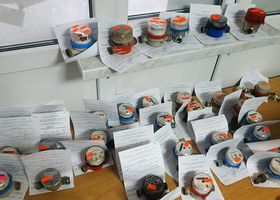Why is modernization of buildings stalling?
Long procedure of the government program and substantial own outlays reduce interest of building co-owners in thermal modernization – Ukrainian energy analysis

The majority of apartment buildings in Ukraine were built before 1994, and therefore, their walls, floor slabs, windows, and heating, ventilation, water and power supply systems have long become outdated and worn. Because of their present condition, energy consumption of these buildings is 1.5 to 3 times higher than that of apartment buildings in the neighboring countries: Poland, eastern Germany and Baltic States. According to data by the Ministry for Development of Communities and Territories, 80% of all (144 thousand) apartment buildings in our country are in the need for modernization. Presently, Ukrainians pay for housing maintenance and utility services much more than they could have. Therefore, residents of certain buildings decided to change this situation by joining Energodim, a new government program.
Up to 70% of costs could be refunded
Unfortunately, the majority of Ukrainians are not wealthy enough today to invest in a comprehensive program for thermal modernization of their apartment buildings. All that certain families can do is to replace windows or insulate a portion of their building’s façade. Many were able to do that thanks to the “warm loan” program. However, it cannot cover the entire complex of measures necessary to reduce the building’s energy consumption and does not produce a consistent energy saving result. To have bigger resources and capabilities, the Energy Efficiency Fund (EEF) launched Energodim program in August 2019.
“This is a government program which offers a partial refund of the costs of energy efficiency measures implemented in apartment buildings run by associations of apartment building co-owners (AABCs), and which envisages thermal modernization of buildings according to European standards,” Yulia Holovatiuk-Ungureanu, Director of the Energy Efficiency Fund, said.
She also explained that this program can refund up to 70% of expenses incurred by the building’s co-owners on energy efficiency measures. In particular, it includes a preliminary energy audit of the building, development of design documentation, construction work, materials, authorial and technical supervision, recertification of the building’s energy performance upon completion of modernization, etc.
“As part of Energodim program, we offer AABCs two packages of energy efficiency measures: “Light” (A) and “Comprehensive” (B). Our Fund refunds 40% of the cost of materials, equipment and construction work under Light package and 50% under Comprehensive package. On top of that, the first 500 AABCs will receive an additional 20% refund. It means that for these AABCs, the total amount of refund will be 60% of costs under Light package and 70% under Comprehensive package,” Yulia Holovatiuk-Ungureanu added.
It is important to emphasize that AABCs can get a refund not only for materials and equipment but also for works and services, which amount to a substantial portion of outlays on thermal insulation of buildings. According to the EEF Director, the list of energy efficiency measures required for a particular building is determined on the basis of professional energy audit, and the quality of work is guaranteed by the authorial and technical supervision. These are the indispensable conditions for participation in Energodim program.
By the way, the grant (refund) is paid to an AABC via a partner bank in the form of three tranches. In April of this year, the loan burden on co-owner associations was reduced to the minimum by enabling AABCs to receive the second or third tranche before fully settling debt to contractors or equipment suppliers. In this case, the EEF will only check whether the AABC made the required minimum payment.
In addition, the latest changes in the program allowed to do step-by-step verification and make step-by-step payment of the third tranche. As a result, an AABC can take out a smaller loan or spend much less in own money. This way, financial pressure on wallets of the apartment building’s co-owners has been significantly reduced.
Thermal modernization will help improve both technical condition and appearance of apartment buildings. Experts say that service life of buildings could be extended by 25-50 years. Moreover, the value of apartments in these buildings will increase – a very convincing argument for their owners in favor of joining the program.
“Over 10 years, an average statistical household will "waste" (overpay) almost 90 thousand hryvnias for heating alone, and this money can easily be saved,” Petro Lavryniuk, IFC regional consultant for support of the Energy Efficiency Fund in the Volhynian Oblast, says. “Therefore, thermal modernization is the best investment in future savings.”
Presently, the program’s results can be evaluated only based on the example of buildings which took part in the EEF’s pilot project First Swallows. According to the EFF’s map showing the participants of this project, these were 15 AABCs. Only six of them received an energy certificate registered in the State Register, while the other nine are at the stage of checking results of their energy audit.
Money is available but the participants are few
In total, the Energy Efficiency Fund received only 70 applications from AABCs since Energodim program was launched in August 2019. We surely wish this number to be much higher. Residents of many old apartment buildings would probably want to participate in this program to live more comfortably and pay less for utility services, but the procedures seem to them too complicated and the initial investment too high to bear.
The Energy Efficiency Fund claims that they are working on improving the procedures. Presently, they want to start, as soon as possible, refunding expenses of AABCs on services of the so-called project managers who can provide professional consultations and professional project supervision, and launch an online application service. But will that make Energodim program so popular among apartment building co-owners that all of them will start rushing their applications in the nearest future?
“The conditions which the Energy Efficiency Fund puts forth today are not for all AABCs,” Tetiana Boiko, coordinator of household utility and energy programs at Opora Network, says. “Therefore, it makes no sense to talk about mass implementation of this program and comprehensive modernization of thousands of buildings in pilot cities this year, as the government claimed. This is an illusion. There were only 70 applications received as of today.”
Still, the expert believes that the biggest problem of Energodim program is very long and complicated procedure. Most of its steps were copied off international analogues, and in the expert’s opinion, it was a big mistake, because the interest rate offered in Europe and what is available in Ukraine are simply incomparable. Therefore, a year or two after an AABC in Ukraine takes out a loan and receives a refund (even 70%), the interest rate will “eat it all up”.
In addition, Tetiana Boiko says, a lot of AABCs have fears that they will have to pay back the money the EEF gave them, because the criteria have not been clearly stipulated. For example, the terms and conditions state that no refund will be made if essential changes are made in the project. “But everyone who ever had to deal with modernization of buildings knows that changes will always have to be made in the project,” the expert says. “Even if we renovate an apartment (especially an old one), we expect that the preliminary estimate of costs will have to be multiplied by at least two, because a lot of nuances and unforeseen problems will definitely pop up during renovation. The same is true about an apartment building: it is impossible to provide for every contingency before starting its thermal modernization, even after completing an energy audit.”
AABCs are also afraid of huge sums involved in a modernization project: would they be able to pay all bills? Therefore, the interlocutor says, if an AABC were able to repay the money borrowed from a bank from its future savings (and the savings will definitely be!), the number of applications would’ve been much higher.
“Even though the program envisages a refund of up to 70% (and that’s a lot), there is a catch: the share of the AABC itself must be at least 15%,” Tetiana Boiko adds. “That’s a lot of money which the building’s co-owners don’t have. Bear in mind that people did not buy most of this housing stock but simply received it, which means that residents of the same building are very different in terms of their income. But if an AABC tries to solve the money problem by engaging financing from other sources, the funding provided by the EEF decreases.” It also scares AABCs. The expert believes that it would’ve been great if the amount of funding from the EEF had not been reduced in these situations.
A revolving fund for loans to start the work
Experts believe that the use of revolving and other funds could become one of the solutions for this problem. And certain shifts have already occurred in this area. Recently, the Board of the Association of Energy Efficient Cities of Ukraine (AEECU) has decided to launch a mechanism of repayable financial assistance to AEECU member cities, creating the Revolving Fund of Cities (RFC).
First, an AABC must invest money it does not have. On the other hand, an audit may cost 20 to 35 thousand hryvnias depending on the building’s size, and further 150 to 300 thousand hryvnias would have to be spent on design and estimation documentation. That’s a lot of money. And that, Sviatoslav Pavliuk believes, is a high barrier, a weak spot of Energodim program.
“We are trying to relieve this burden by creating the Revolving Fund,” he says. “In our realities, this fund is a method to borrow interest-free money from the city budget for people who want to modernize their building and then pay this money back to the budget. In other words, building co-owners borrow money, do renovation, receive a refund from the Energy Efficiency Fund and pay money back. After allocating a certain amount once, the city can use it again and again and engage a lot of buildings in the Energy Efficiency Fund’s program. Our estimates show that if the city were to allocate every year an amount sufficient for modernization of one building, during five years we would have been able to renovate approximately 55 buildings, because the money turns over several times. To be sure, this money somewhat depreciates because of inflation, but it doesn’t get lost altogether.”
Today, the pilot mechanism of the Revolving Fund is being launched in eight cities (Zhytomyr, Kamianets-Podilskyi, Lutsk, Novohrodivka, Dolyna, Slavutych, Vinnytsia and Myrhorod), and a significant shift is expected to occur in Energodim program, first of all, because of the increasing number of AABCs in the country, and therefore, of the program’s participants.
However, this is only one of the additional mechanisms of solving the problem. What else can be done? “The government allocated 100 million hryvnias for “warm loans” to AABCs,” Tetiana Boiko added. “And certain branches have already run out of money, because people actively take these loans out. I think that overall, the money will last only till the end of the quarantine. At the same time, the Energy Efficiency Fund has a lot of money, but AABCs are not eager to participate in Energodim program. Moreover, for many of them the participation became impossible because of the quarantine. Therefore, I believe that the government should have left “warm loans” for small projects, because people are prepared to participate in this kind of projects, and carry out complex projects via the Energy Efficiency Fund and all existing procedures. In addition, the Fund could’ve offered “Ultralight” package – basically the same thing as “warm loans” but with the result verification option. So now, the ball is in court of the Ministry for Regional Development and the Ministry of Energy and Environmental Protection.”
Svitlana Oliinyk for Ukrainian Energy








